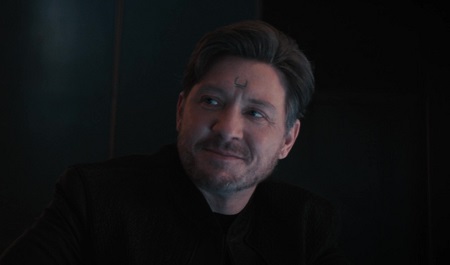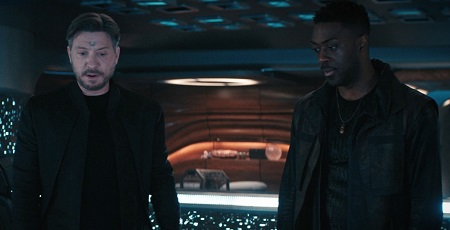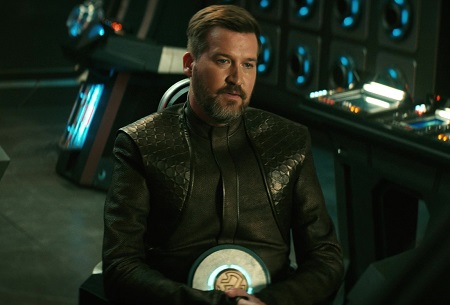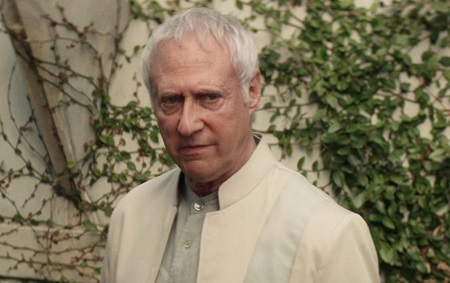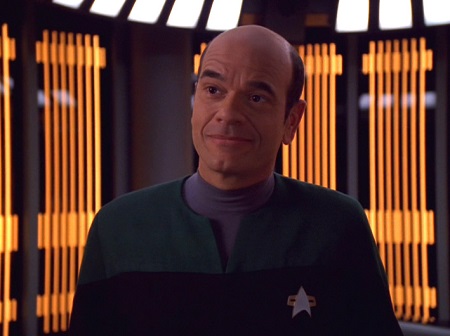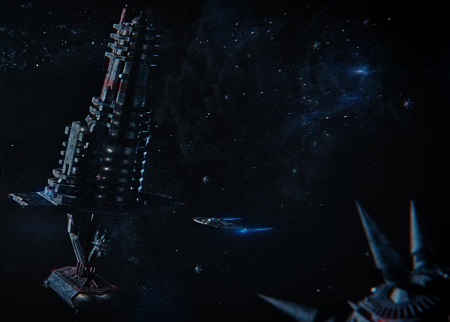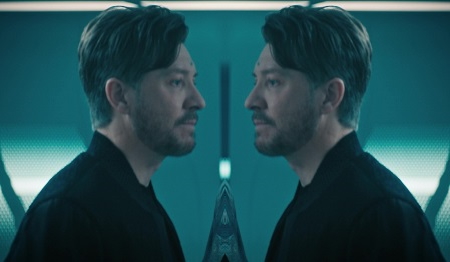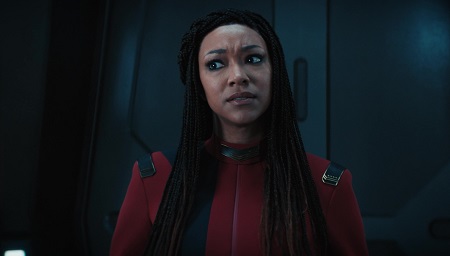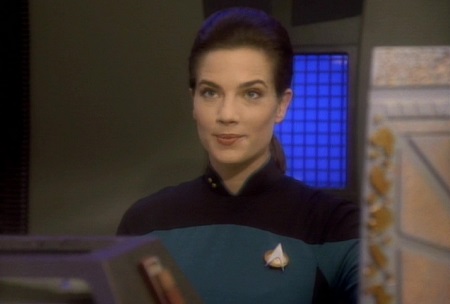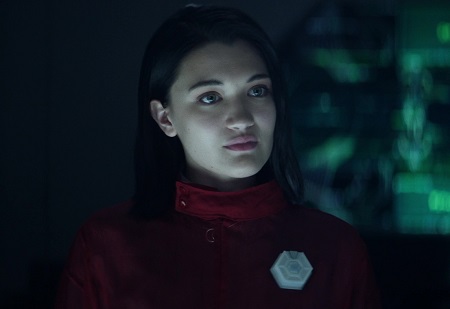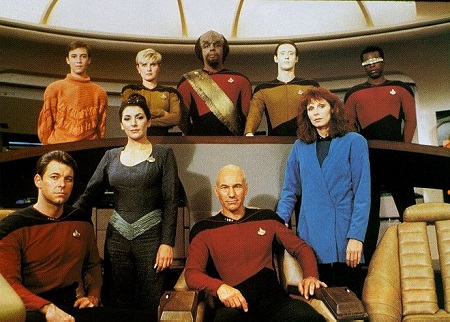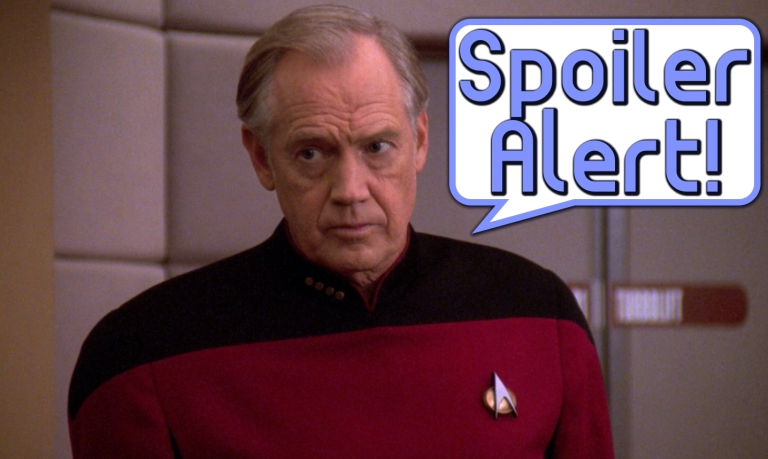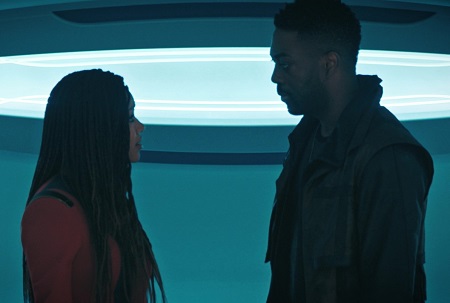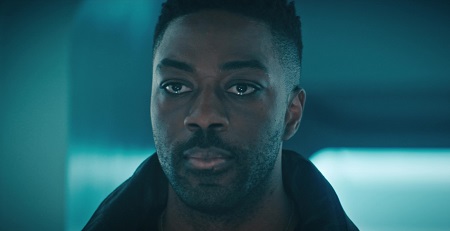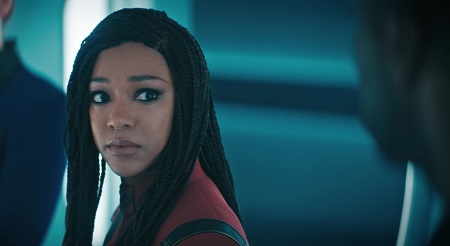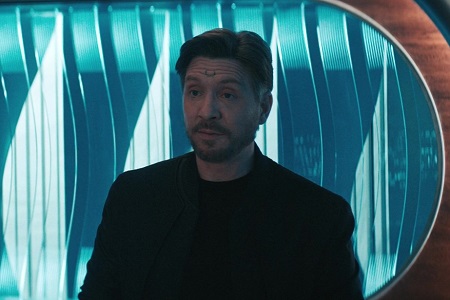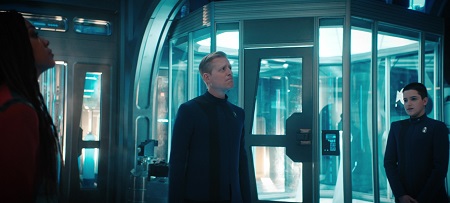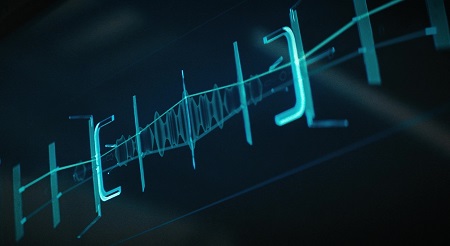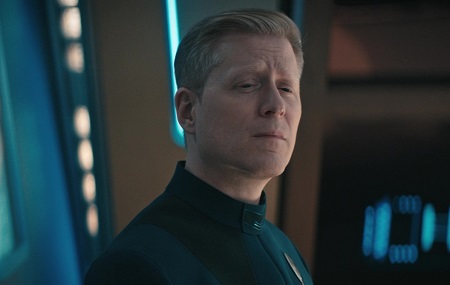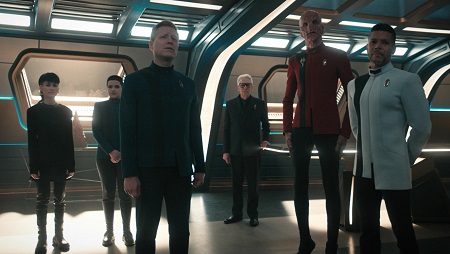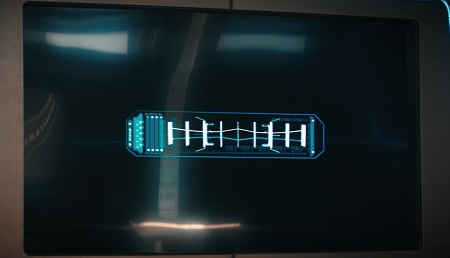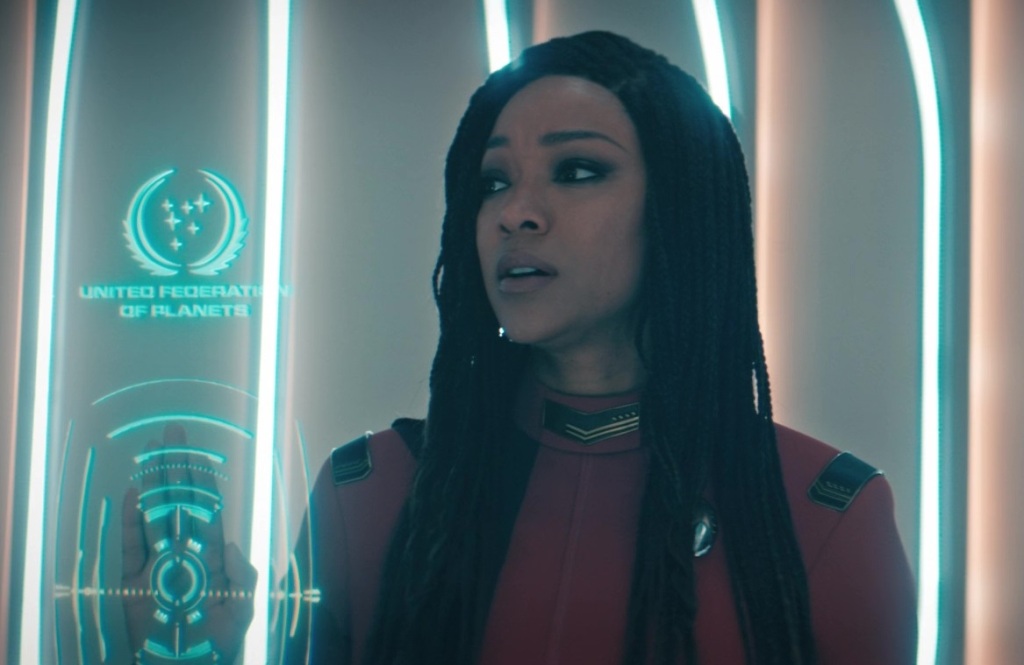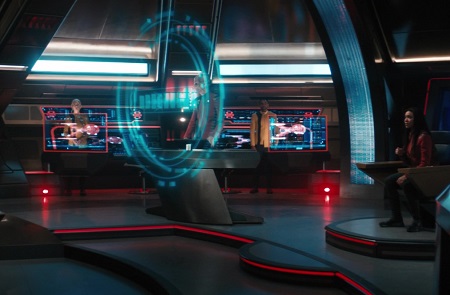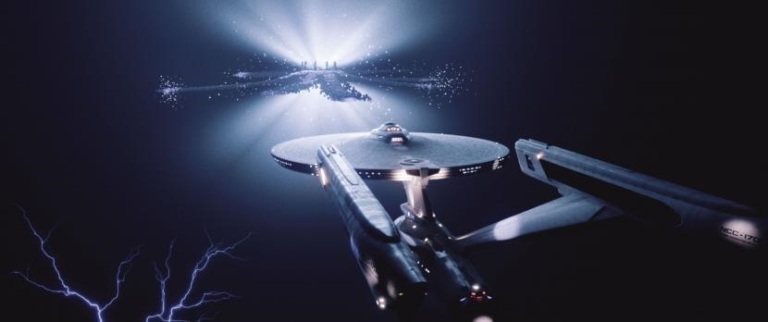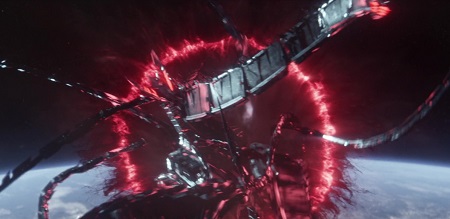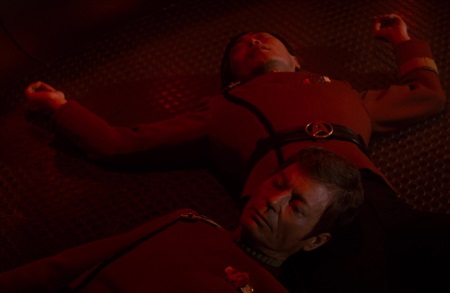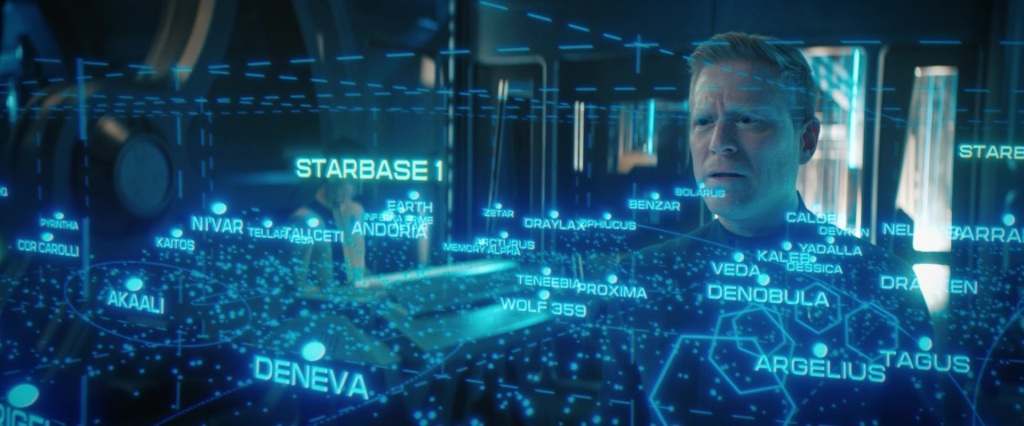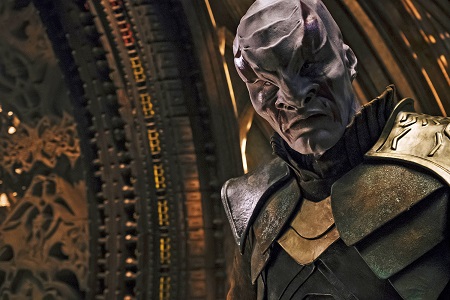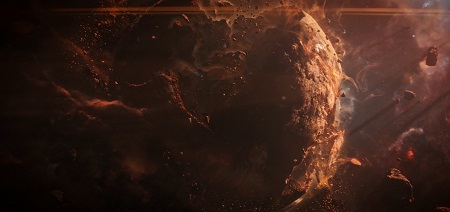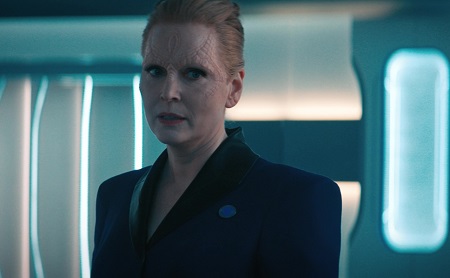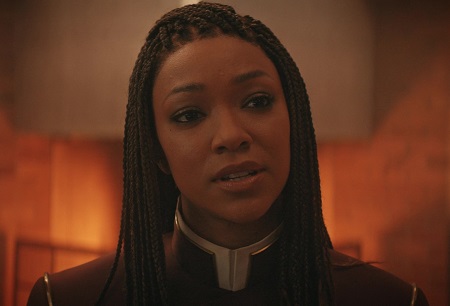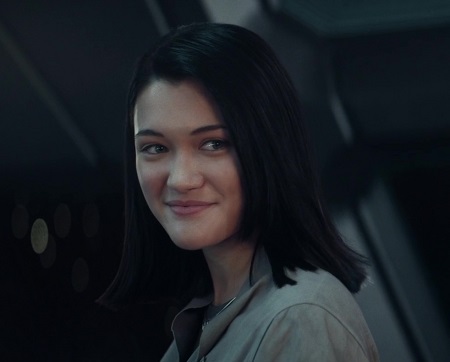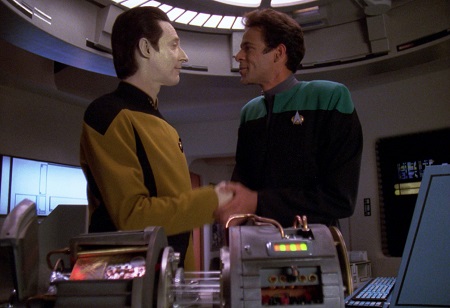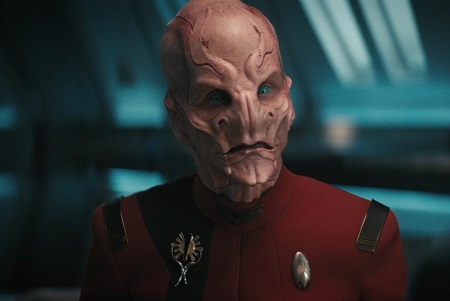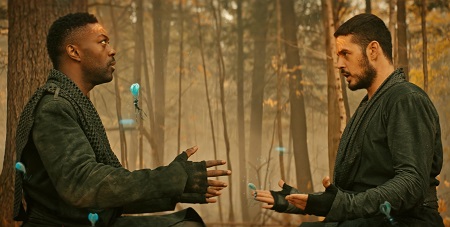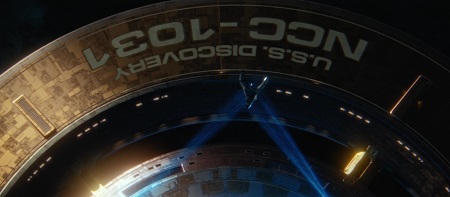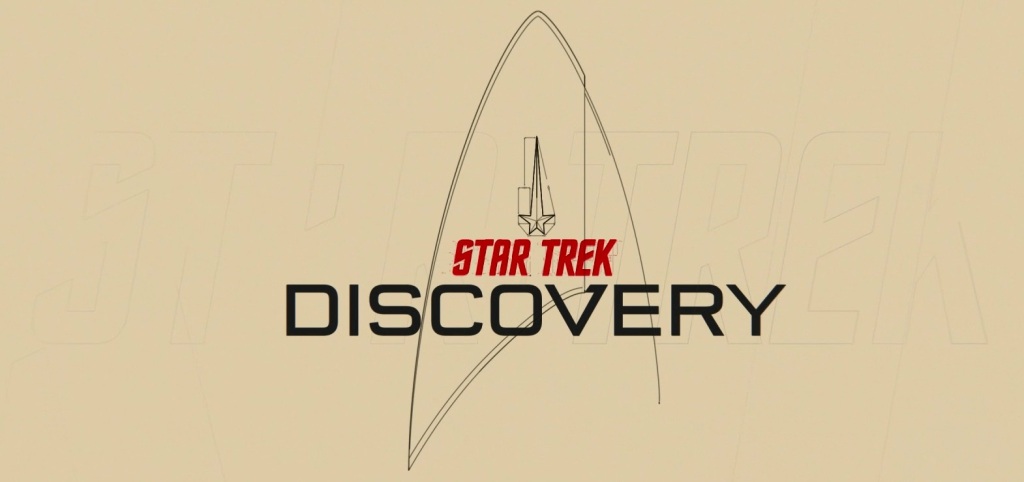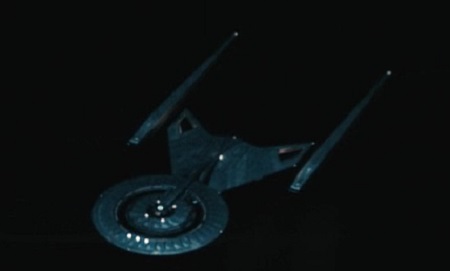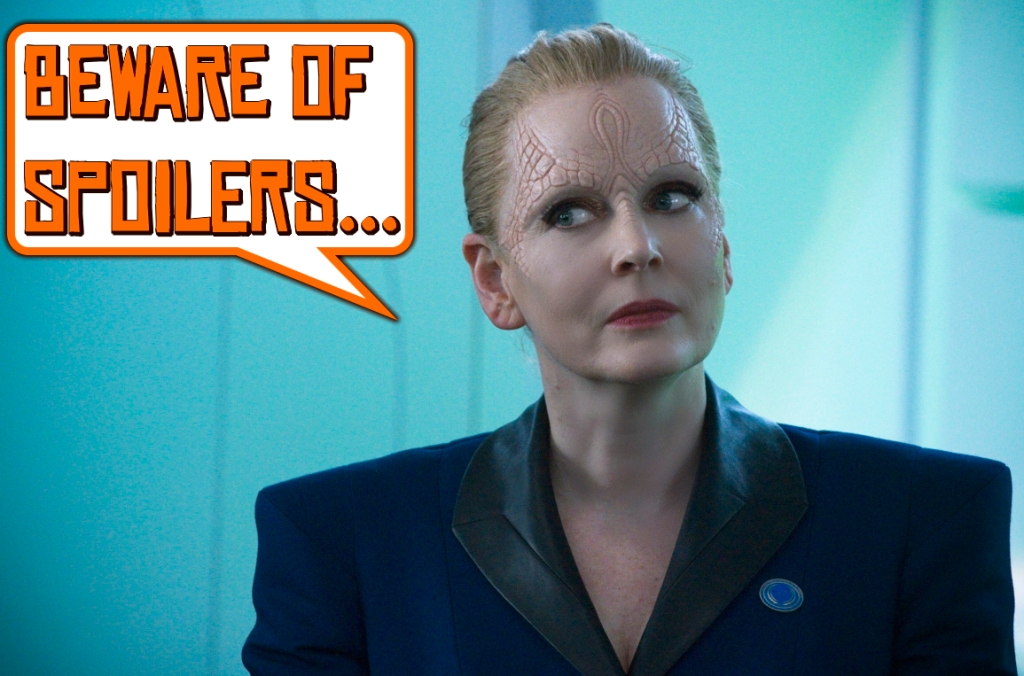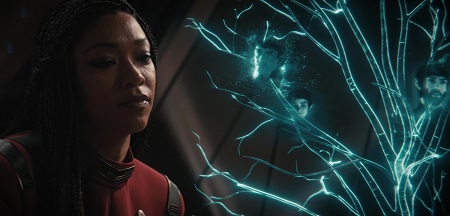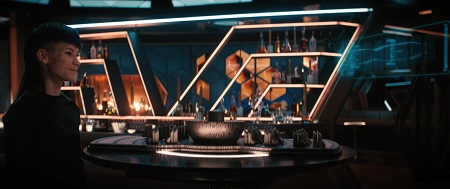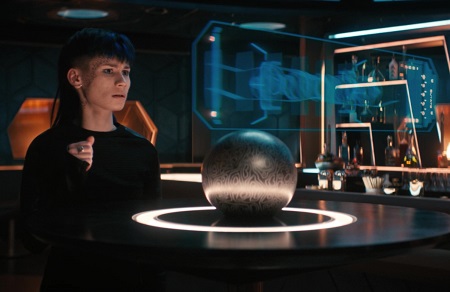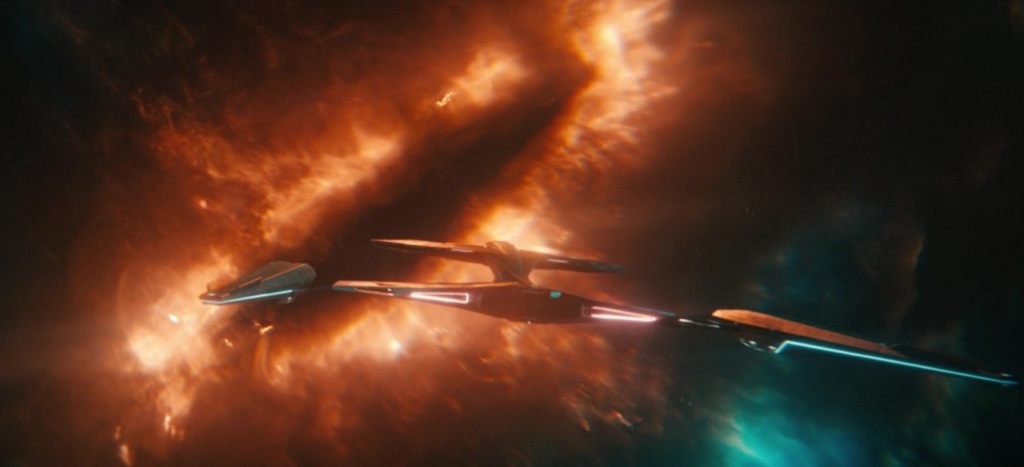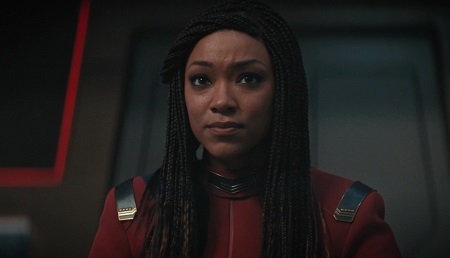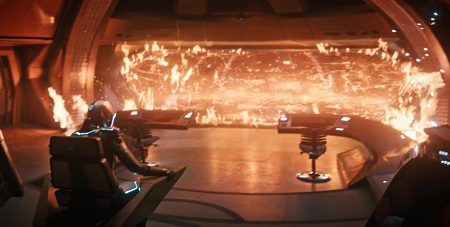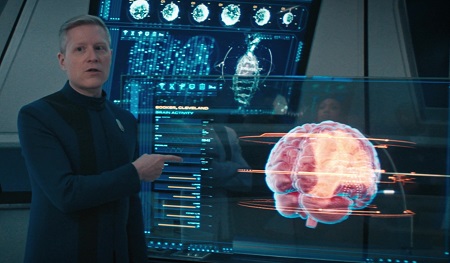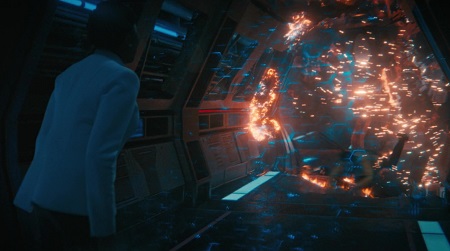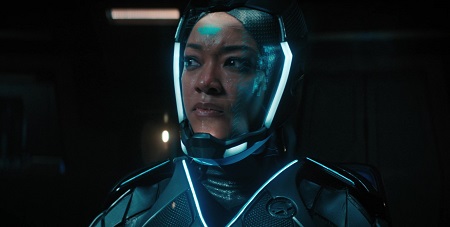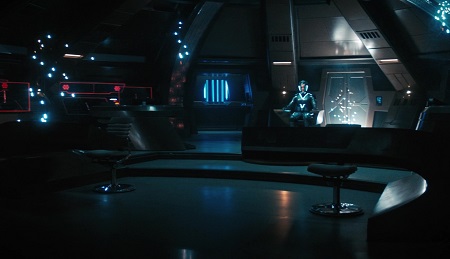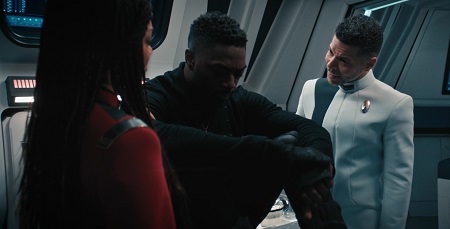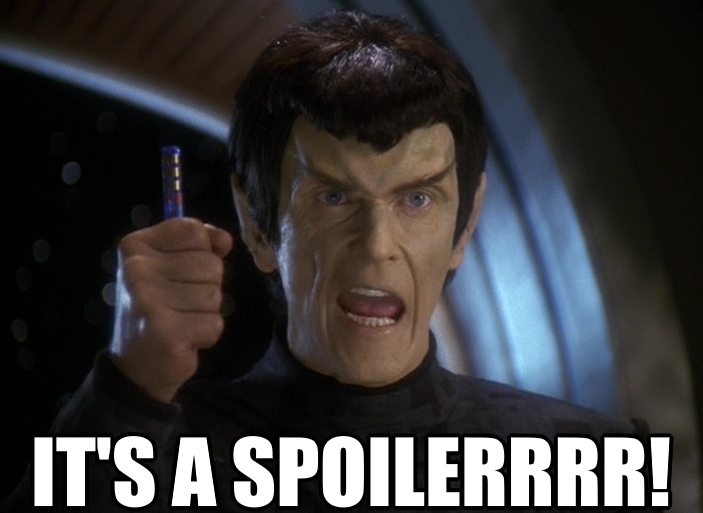
Spoiler Warning: There are spoilers ahead for Star Trek: Discovery Season 1-4, Star Trek: Picard Season 1, and for other iterations of the Star Trek franchise.
After All In failed to move the needle in a major way, Rubicon came along! The latest episode saw a minor theory cull, with three theories being debunked – and a couple of others moving ever closer to being struck off the list! As the season builds up to its conclusion, this was bound to start happening, and I don’t lament the passing of any of the theories that didn’t pan out. We also had a rare confirmation this week, and with fewer new theories to talk about, the list will shrink for the first time in several weeks!
On reflection, perhaps I was a little harsh on Rubicon in my review. The episode was decent, but it suffered because I find myself struggling to get invested in the Book-versus-Burnham relationship squabble storyline, and that’s been a dominant force over the past couple of episodes in particular. I’m still hopeful that Discovery will find a sensible – and fairly quick – resolution to this, but at the same time I think I need to try to be less petty about it!
So let’s take a look at the confirmation and the debunkings before we jump into the main list.
Confirmed theory:
Tarka’s weapon will be successful.
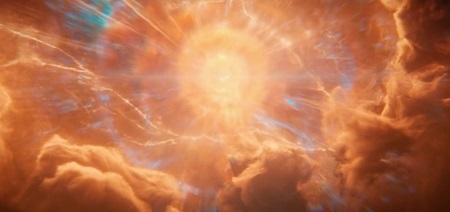
The obvious path for a “happily ever after” kind of story would have been for Captain Burnham and the crew to stop Book and Tarka before they had a chance to use their weapon. And, to her credit, Captain Burnham was inches away from success as she managed to talk to Book and convince him not to deploy the weapon.
But I guess that in her haste to patch things up with her boyfriend, Captain Burnham forgot about Tarka. And Book likewise didn’t make sure that Tarka was on board with his decision to wait for the communication attempt, as Tarka launched his weapon the second Book and Burnham finished their conversation.

I’m glad that the story took this route. It potentially opens up a more interesting meeting with Unknown Species 10-C, one with more tension and the possibility of conflict. But most importantly, Tarka remained true to his characterisation. He didn’t back down just because Book had a change of heart, and he wasn’t able to be persuaded by Captain Burnham’s request.
Tarka remains an interesting adversary. I don’t want to call him a “villain,” not exactly. He has a complexity and a nuance that makes his motivation understandable, even if his “ends justify the means” approach could very well lead to people getting hurt. I’m not ready for Discovery to get rid of Tarka… and I confess that I’m still rooting for him to find a way across the divide between universes.
So that theory was confirmed.
We also have several debunkings to get through, so we’ll run through those next!
Debunked theory #1:
Nhan works for Section 31.
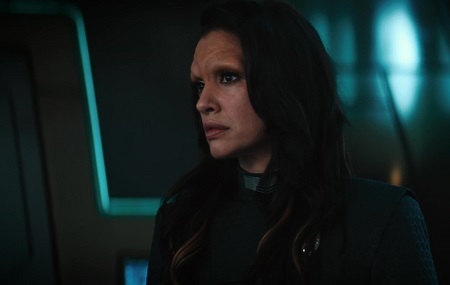
This was a fairly straightforward one by my standards! When we saw Nhan in the promos for Rubicon, I theorised that she might be wearing a different uniform to the standard Starfleet ones worn by Captain Burnham and the crew because she had been recruited by Section 31. She could have been given a Section 31 mission aboard Discovery – perhaps connected to the DMA.
But it didn’t come to pass! Nhan works for Starfleet Security, and has spent some time as a soldier helping the Federation battle against the remaining forces of the Emerald Chain. She doesn’t appear to be making a big return to Discovery, either, merely appearing in a guest role in Rubicon.
Debunked theory #2:
Tarka will realise that there’s a tracker on the isolynium.

This was another fairly simple one by my standards. In short, I speculated that Tarka would check the isolynium that Book procured and figure out that a tracking device had been placed on it. It seems like the kind of thing he might’ve done; he’s been thorough when it comes to his work, and he clearly didn’t fully trust Haz Mazaro.
But Tarka didn’t check, or if he did off-screen he didn’t find the small tracking device that Captain Burnham had placed. If this theory had panned out we could’ve seen Captain Burnham and the crew having to pick up the trail another way, or even being led into a booby-trap of Tarka’s devising! In a longer season, perhaps such a detour would have made sense. With only four episodes left, I guess wasting an episode chasing down Book and Tarka would’ve been extraneous fluff.
(Probably) debunked theory #3:
The DMA is (or was) a life-form.
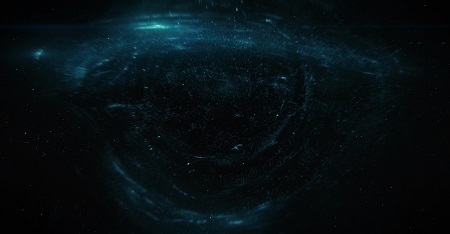
It was never stated outright in clear-cut terms, but this theory now feels sufficiently unlikely that I’m striking it from the list. If the DMA was alive… it isn’t anymore! Tarka’s weapon saw to that. The arrival of a second DMA within moments of the demise of the first seems to confirm that the destructive anomaly is little more than a tool; the dredge or mining equipment that Captain Burnham and others figured out at the end of All In.
Unknown Species 10-C could still be a synthetic race, so the concept of a life-form on the scale of the DMA is still plausible in Discovery Season 4. But the DMA itself now seems certain to be little more than a tool – whoever is controlling it is the sentient one. It might’ve been interesting if the DMA had been alive, with a story similar to The Motion Picture perhaps unfolding from that premise. But now we must look to Unknown Species 10-C!
So those theories have been debunked!
Now let’s jump into the main theory list, beginning with those theories that are either new or saw movement in Rubicon. Then we’ll conclude with a few theories that are still in play, but which Rubicon didn’t touch.
Theory #1:
Unknown Species 10-C built the Galactic Barrier.

I’ve never been wild about the Galactic Barrier in Star Trek. It’s something that dates right back to the very beginning of The Original Series, but it’s always struck me as a bit of an oddity; an element of pure fantasy in a setting that prefers to base its astronomy on real science. The Galactic Barrier is also rather poorly explained, and can seemingly be ignored at the whim of Star Trek’s writers – some episodes depict crossing it as being impossible, others show starships moving through it with ease. It also feels like a 2D anachronism in the 3D realm; unless the galactic barrier is a sphere, surely flying up and over it should be possible!
But maybe we’re about to learn more about this strange phenomenon. Given their technological capabilities, it doesn’t seem impossible that Unknown Species 10-C constructed the Galactic Barrier – perhaps as a way to shield themselves from the races of the Milky Way, or perhaps to keep anyone from exploring too far and discovering their location. There are many reasons why a technologically advanced race might want to build something on this scale – and we could even learn that the harvested boronite is being used to fuel the Galactic Barrier itself.
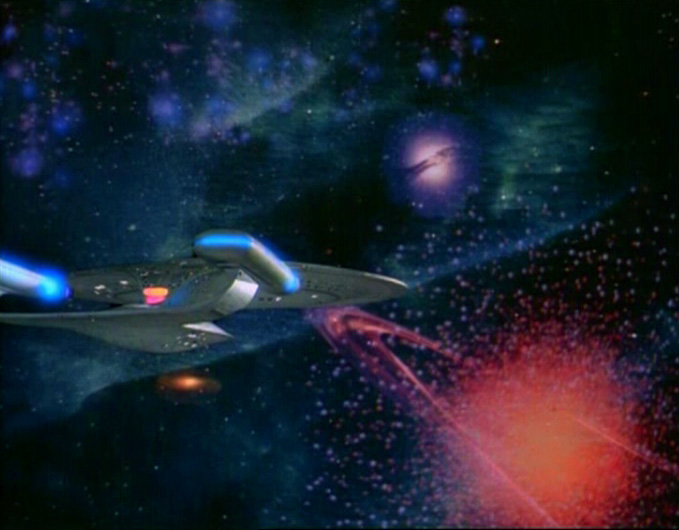
One possible explanation for why Unknown Species 10-C might want to build something like the Galactic Barrier is to keep the Milky Way’s inhabitants in… but it could also be a shield designed to keep someone else out. That raises a very frightening question: what could be so powerful that a barrier is needed around the entire galaxy? And what could be so dangerous that being locked inside a galaxy with the Borg would be preferable?
With Unknown Species 10-C seemingly being very secretive, I think the idea of them building it to shield themselves is more likely… but there are definitely a lot of ways this theory could go!
Theory #2:
Someone else built the Galactic Barrier to keep Unknown Species 10-C out.
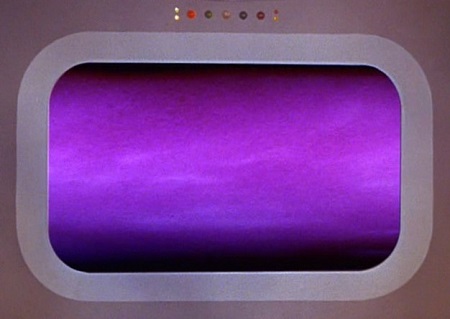
If the Galactic Barrier is an artificial construct, perhaps it was created by another race or faction as a shield against Unknown Species 10-C. It could be the case that Unknown Species 10-C has used DMA technology against the Milky Way in the distant past, and some other race or faction constructed the Galactic Barrier to keep them out. If Unknown Species 10-C are belligerent and interested in conquest, it might take something on a galactic scale to keep the Milky Way safe.
The Q Continuum spring to mind as a possible candidate if the Galactic Barrier was artificially created. Admiral Vance mentioned the Q a few episodes back, saying that there hadn’t been any contact for more than 600 years. Given that the Q – or at least one member of the Continuum, at least – were very interested in the progress of races like humanity, perhaps they took a decision to “seal” the Milky Way to protect its inhabitants from Unknown Species 10-C.

Obviously this theory and the one above can’t both be right! And it’s a distinct possibility that the Galactic Barrier element of the story is just a convenient macguffin to blind Starfleet to Unknown Species 10-C and prevent easy travel to their region of space, dragging out the story and prolonging attempts at communication so other narrative threads could play out.
If that’s the case, we may learn nothing about the Galactic Barrier in the episodes that lie ahead! However, I still think it’s interesting to consider the possibilities, and it could be fun to finally get some more detail on this lesser-known but significant aspect of the Star Trek galaxy.
Theory #3:
Tarka’s mysterious “friend” is someone we’re already acquainted with.
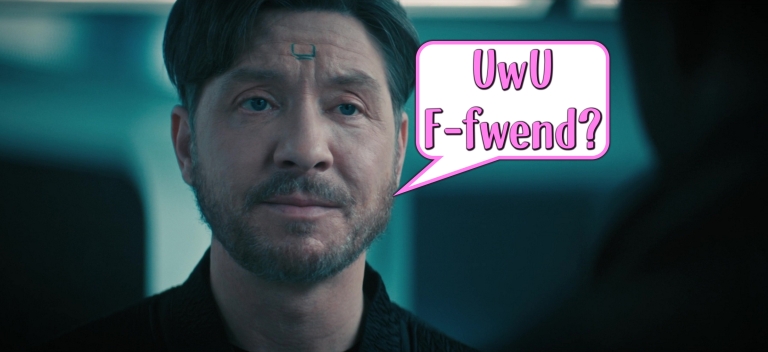
At this point in the story, there’s no need to conceal the identity of Tarka’s friend – unless the revelation of this person’s identity is going to be a huge surprise. It’s possible that there is no Unknown Species 10-C, for example, and that Tarka’s friend is the one responsible – a theory we’ll look at in more detail in a moment! But it has to be considered a possibility that Tarka’s friend is someone we’ve already met, either in Discovery or in another iteration of Star Trek.
Rubicon hammered home Tarka’s desperation to reach his friend, and All In had given us a quote from Tarka about his grief at this person’s loss being unfathomable. Perhaps that was hyperbole on the part of someone very self-centred, but even so it feels like there’s more going on with this mysterious character. If there’s nothing special about them, and they’re just a brand-new character called something like Albert or Gladys, then why go to such trouble to keep their identity hidden during every conversation? It’s setting up a mystery – and for Discovery’s sake I sincerely hope it goes somewhere!
I put together a short list of possible candidates for being Tarka’s mysterious friend, and you can find it by clicking or tapping here.
Theory #4:
Unknown Species 10-C is a faction from a past iteration of Star Trek.
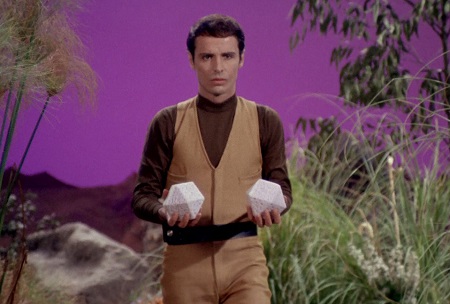
Rubicon didn’t do much to advance this theory – though the DMA controller seemed to bear a very superficial resemblance to omega molecules and possibly Borg tech – but comments from Discovery’s showrunner during a social media event may indicate that this theory isn’t going to pan out, despite the mysterious elements and references to past Star Trek shows scattered throughout the season. In short, Michelle Paradise spoke about “designing” Unknown Species 10-C and how they’re “unlike any species we’ve seen before.”
It’s still possible that we’re dealing with a faction like Picard Season 1’s super-synths, who were only seen on screen very briefly, or an extensive redesign of a race like the Borg to reflect centuries’ worth of technological progress. But I felt it was worth bringing this up, as it’s certainly our biggest indication to date that Unknown Species 10-C may be someone brand-new to the franchise.
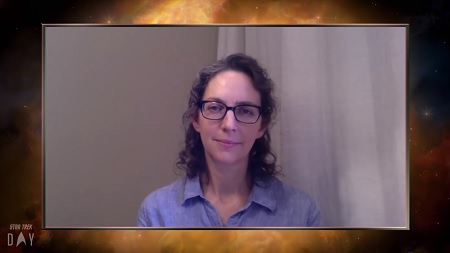
I said last time that I was beginning to get a sense of déjà vu. Many of the suspects for Unknown Species 10-C also felt like plausible culprits for the Burn in Season 3 – and the way that storyline ultimately wrapped up was unpredictable (to say the least). As Trekkies who are invested in this fictional setting, I think there’s always going to be a desire to speculate and theorise about how big events in new stories could be connected to the elements from elsewhere in the franchise… I just hope that the ultimate reveal of Unknown Species 10-C doesn’t prove too disappointing if it has nothing to do with Star Trek’s past.
All that being said, there are still some plausible suspects, even if the DMA’s level of technology would seem to rule out many familiar races. The Borg, Enterprise’s Sphere-Builders, the extragalactic Kelvan Empire, V’Ger, Species 8472, the Q Continuum, and the Terran Empire are all high on my list! For a more detailed look at them, as well as a few less-likely contenders, check out my full list by clicking or tapping here.
Theory #5:
Book and Burnham will reconcile and get back together.

Although I may have been excessively critical of it at points in this week’s review, I maintain that the Book-versus-Burnham conflict isn’t one that the show needs. It’s built on very weak foundations, with both of them (and everyone else on the show) needing to be incredibly blinkered (or incredibly stupid) and not being able to recognise a very basic pathway to the “middle ground” that became the focus of Rubicon’s story.
We saw a big step toward reconciliation – at least on Book’s part – in Rubicon, when he agreed to stand down and give Burnham and Starfleet a week to attempt to make peaceful first contact and convince Unknown Species 10-C to deactivate the DMA. Book was willing to take a risk by trusting that Burnham would permit him and Tarka to go ahead with their plan at a later time… whether she would or not is unclear!

So that’s a positive step. With the detonation of Tarka’s weapon, the story could go in one of two ways from here: either Starfleet will let them off the hook, with the debate over the weapon rendered moot by the arrival of a second DMA, or Book and Tarka will have to go on the run to avoid the consequences of their actions.
I would suggest that Tarka is a valuable asset to Starfleet, and they may want to bring him back into the fold to help work on the DMA problem, the Galactic Barrier problem, and other things. Book is far less important in that regard, but as he’d indicated his willingness to stand down he may not be in as much trouble. There’s a pathway here to bring an end to this feud – and I hope Discovery takes it in the next week or two.
Theory #6:
Michael Burnham won’t remain captain of the USS Discovery.

One potential way to pay off the Book-versus-Burnham storyline would be for it to lead to a significant change for Discovery’s captain. We saw in Rubicon that Burnham was unwilling to give the order that could have hurt or killed Book – even though she had been ordered to do so by Starfleet. This fundamental conflict between her romantic relationship and her duty is not new, and could potentially lead to Burnham stepping back from her role as captain of the ship.
Maybe she will have the strength to do what she believes is right during the DMA crisis, but will resign afterwards, unable to contemplate doing the same thing again and wanting to return to her simpler life with Book. This wouldn’t be a bolt from the blue, as we saw her wrangling with these feelings in Season 3.
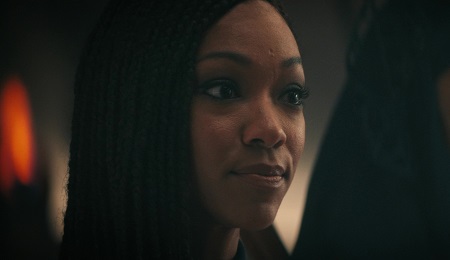
One of the unique aspects of Discovery within Star Trek’s broader canon is that the ship has been commanded by four very different individuals across its four seasons. Captain Burnham is different from Saru, Saru was different from Pike, and Pike, in turn, was different from Lorca. It has to be considered at least a possibility that the series will continue this trend.
I’m not really in favour of this, but it’s certainly interesting to consider. Now that we know that Season 5 is definitely happening, one possibility is that Captain Burnham will somehow leave the ship at or around the end of Season 4, making way for a brand-new commanding officer to take over. Because she’s been the show’s protagonist since Season 1, it seems unlikely, and the overall arc of Discovery between Season 1 and Season 3 can be read as Burnham’s redemption and ascent to the captaincy. But the show’s revolving door of captains may continue, and her conflict with Book and the difficult emotional situation it put her in could be the trigger to make this happen.
Theory #7:
Tarka will create his own DMA.
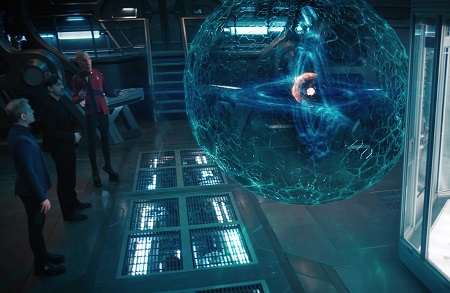
In The Examples, we saw Tarka – aided by Stamets – building a scale model of the DMA. Now that his plan to destroy it and seize its controller has failed, perhaps he’ll attempt to recreate the device using the knowledge he acquired. If so, he could inadvertently create a new DMA. Or, through time travel shenanigans, Tarka could turn out to be the creator of the original DMA!
Tarka’s story isn’t finished yet, and there’s still time for him to devise and enact a new plan over the course of the next few episodes. He had plans for using the DMA controller, so the next-best thing from his point of view might be to build his own version. He’s certainly clever enough – all he really needs is access to the resources to pull it off.
Theory #8:
Tarka’s friend built the DMA.
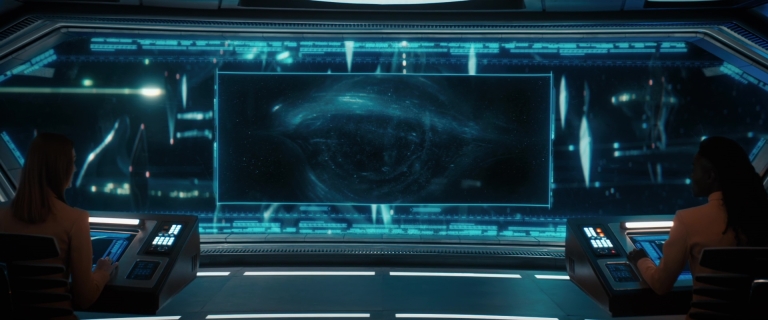
As mentioned above, I think it’s a possibility that Tarka’s friend is directly involved with the DMA. It would explain how Tarka seems to know so much about it, even being able to recreate it on a smaller scale, as well as how he knows that it would be possible to use its power source to punch through to an alternate universe.
After all of the buildup, it’s possible that Unknown Species 10-C could turn out to be a single person: Tarka’s friend. It’s also possible that Tarka’s friend is working with Unknown Species 10-C, perhaps trying to find a way to reach Tarka across the divide between universes. There are a lot of different ways that this could pan out!
So those theories are new or saw movement this week.
Now, as I do every week, I’ll recap all of the other theories currently in play. I find it helps to keep everything in one place – it makes it easier to keep track of every theory so we can strike them off the list as we go!
Theory #9:
We haven’t seen the last of the Abronians.
I currently have four ideas for different ways that the Abronians – the non-humanoid race that Captain Burnham, Tilly, and the Qowat Milat helped save from cryo-sleep in the episode Choose To Live – could play a further role in Season 4.
Theory #9-A:
The Abronians’ homeworld was destroyed by the DMA.
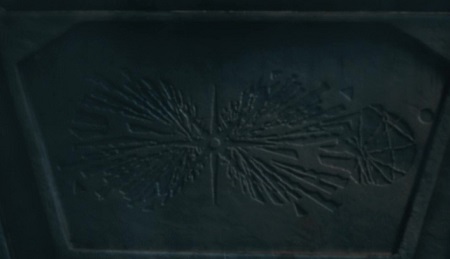
After arriving at the Abronians’ cryo-ship, Captain Burnham found a stone carving that seemed to depict the destruction of the Abronians’ homeworld. This carving was only shown on screen briefly, but it seemed to show the planet being damaged or destroyed in a large explosion. Burnham credited the planet’s destruction to a “supernova,” and the story then raced ahead.
Considering that the main thrust of the season so far has been about the DMA, perhaps Burnham was incorrect: the Abronian homeworld was destroyed by the anomaly, not a supernova.
Theory #9-B:
The Abronians’ homeworld was on the other side of the DMA.

Now that we know a little more about how the DMA works, this theory seems a little more plausible. Its powerful wormhole technology seems capable of transporting matter over many light-years, meaning it doesn’t seem to be a complete stretch to think that the Abronians may have originated in the vicinity of Unknown Species 10-C. They could even be Unknown Species 10-C!
One thing struck me as odd about the Abronians: the Federation was entirely unaware of them, despite the Abronian cryo-ship being relatively close to Federation space – such that Captain Burnham could reach it using Book’s ship in a short span of time. It’s possible that the Abronians had been asleep for millennia, unnoticed by the Federation and the wider galaxy for all that time. But it’s also at least possible that their cryo-ship is a newcomer to the area. If so, perhaps it arrived here via the DMA.
Theory #9-C:
The Abronians will return to help the Federation later in the season.
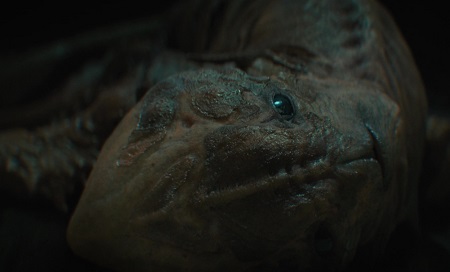
One of the themes of Discovery since Season 3 has been connection, including building connections between the Federation and other races and organisations. The Abronians were awoken from cryo-sleep thanks to the interventions of Captain Burnham and Tilly – at least in part – and they may seek to repay the Federation, or Captain Burnham personally, for that help.
We saw this play out last season with Ni’Var; in the season finale Ni’Var ships raced to the Federation’s aid as the Emerald Chain attacked. Perhaps the Abronians will likewise step up to help when the Federation needs allies.
Theory #9-D:
The Abronians’ moon-ship may be useful in a later story.

The Abronians’ cryo-ship is huge, and at least superficially seems to have the mass of a moon or small planetoid. If Captain Burnham and the crew needed a starship that large, such as to aid in the evacuation of a planet threatened by the DMA, for example, perhaps they’ll return to the Abronians and ask to borrow it.
As we saw in Choose To Live, the moon-ship was in full working order. All it needed was some extra dilithium to power up and it was perfectly capable of moving under its own power, and its computer systems were still functional. The only system that seemed to have failed was the wake-up timer! Discovery has precedent when it comes to telling seemingly one-off stories that have a pay-off later on, so watch this space. If Captain Burnham and the crew need a huge starship urgently, we may not have seen the last of the moon-ship!
Theory #10:
The Red Angel suits from Season 2 are connected to the DMA.
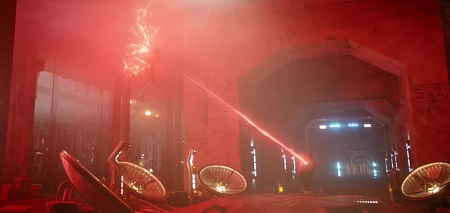
Unknown Species 10-C seem to be responsible for building the DMA… whoever they ultimately turn out to be! But the DMA isn’t the first wormhole-creating technology that Discovery has introduced us to. The Red Angel suits in Season 2 were also capable of creating powerful wormholes… so could it be possible that Unknown Species 10-C built their device around or based on the same technology?
This revelation would greatly affect Captain Burnham, as she’d feel a degree of responsibility even though she wasn’t directly involved. It would also be the second disaster in a row (following the Burn) in which the Federation was implicated – albeit in an oblique way. I’m not convinced that Discovery will go down this route… but the similarities in the wormhole-creating technology gives me pause, at least.
Theory #11:
Saru will be given the captaincy of the USS Voyager-J.
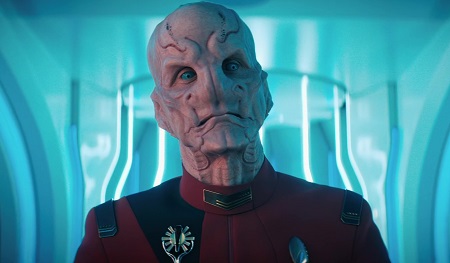
Saru’s future was briefly discussed before he offered to serve as Captain Burnham’s first officer in the episode Anomaly. He has already been offered a command of his own, so Starfleet clearly values his command abilities and experience. President Rillak was seen to be assessing Captain Burnham’s suitability for the captaincy of the USS Voyager-J in Kobayashi Maru… and she mentioned having a shortlist of candidates. Could Saru be on her list?
Several of the qualities that President Rillak said she was looking for in a potential captain seem to apply to Saru. He’s more level-headed, less likely to put himself in a dangerous situation, and more inclined to think of the big picture. He has a weakness when it comes to Kaminar, as we saw toward the end of Season 3, but generally speaking he isn’t someone who lets his emotions get the better of him. His wisdom and calm demeanour could be valuable in the captain’s chair of the Federation flagship. This could also set the stage for his departure from the show, or possibly even for a new show following his adventures aboard his new ship.
Theory #12:
The ban on time travel will be explained in more detail.

This one is as much a hope as a theory right now! In short, the ban on time travel was introduced early in Season 3 primarily as a way for the writers and producers to avoid questions about why the 32nd Century was so different from how the far future had been depicted in earlier Star Trek productions, as well as to explain things like how the Burn was able to catch the Federation off-guard and why Georgiou couldn’t simply be sent back in time when she needed to.
But the ban itself raises some issues – the biggest one being the lack of detail on how it works and how something like this could possibly be enforced. As I said several times last season, it isn’t possible to just un-invent a technology so useful and powerful as time travel. Even just a few lines of dialogue going into a little more detail on the mechanisms involved in the ban would be really useful.
Theory #13:
The Federation has flouted the ban on time travel.

Sticking with the time travel ban, another theory I had last season was that the Federation – and Section 31 in particular – might have deliberately flouted the ban and failed to abide by the rules. Someone as straight-laced and committed to Starfleet ideals as Admiral Vance is highly unlikely to have sanctioned such a move, but there are other Federation leaders – such as President Rillak – who could be implicated.
I don’t think it’s possible any more that the DMA story will be connected to the time travel ban, as I had previously proposed. But that doesn’t mean that a closer look at the ban, and the potential for the Federation to have tried to work around it, isn’t going to happen.
Theory #14:
The crew will have to defend the Verubin Nebula.
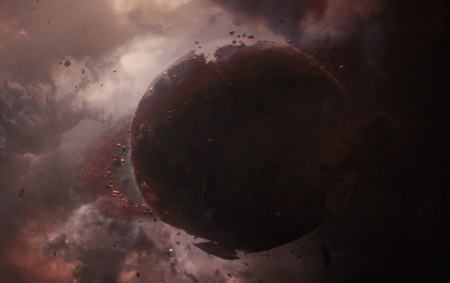
This one is definitely hanging by a thread right now. Season 4 continues to unfold in a very different direction, largely ignoring the main story beats from Season 3. But the dilithium shortage has been mentioned more than once, and as things stand right now, the Federation is in control of the galaxy’s only significant dilithium supply. The Verubin Nebula is almost certainly going to be a target – even if Unknown Species 10-C don’t care about it.
It begins to stretch credulity to think that all of the belligerent factions and races present in the galaxy would become aware of the Federation controlling this impossibly valuable resource and wouldn’t want to take it for themselves. And while it may not happen now until after the DMA storyline has run its course, I think sooner or later someone is going to want to steal the Verubin Nebula and its dilithium. Maybe it will be at the end of Season 4, maybe it will be in Season 5… who knows?
Theory #15:
A major character will be killed off.
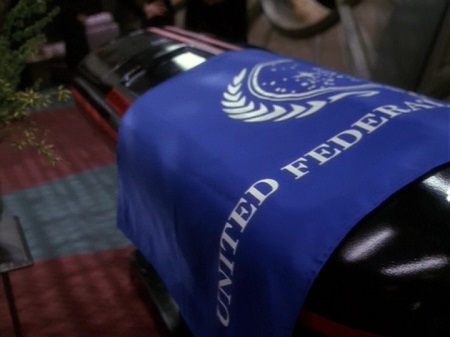
Lieutenant Tilly’s departure in All Is Possible definitely shook up the cast. And Gray’s departure in But To Connect may do so as well. However, I stand by what I said before the season aired: killing off a character can be a great way to demonstrate the dangerous nature of the circumstances that the crew have found themselves in. So far, despite tangling with the DMA on several occasions, only a couple of redshirts have lost their lives.
In Stormy Weather, Dr Pollard raced through the corridors of the USS Discovery to reach a hull breach, but she survived while a nameless redshirt was blown out into space. And in Rubicon, the shuttle mission saw Saru, Dr Culber, Rhys, and Bryce all in serious danger, but they all made it home. Moments like these can make it feel that Discovery is shielding even its minor characters with some pretty heavy plot armour, but I still feel that there’s scope to see a major character death before the season ends.
Theory #16:
Season 4 will connect with the Short Treks episode Calypso.
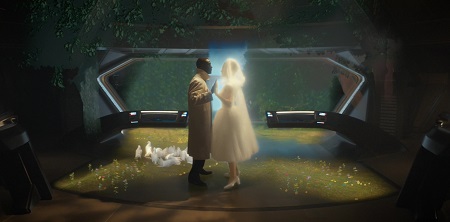
Zora’s status as a member of the crew was confirmed in But To Connect, and this followed her developing emotions and sentience earlier in the season. Zora is now much closer to her presentation in Calypso, potentially bringing the story of the Short Treks episode one step closer.
There are still significant hurdles to overcome if the story of Calypso is to be wrapped up in Season 4, though. Obviously we have the timeframe issue: will the USS Discovery be sent back in time, be abandoned, or is Calypso taking place centuries in the future? Then we have the USS Discovery itself – it’s been retrofitted since arriving in the 32nd Century, and now looks very different to how it did in Calypso. I’m not sure how Discovery will overcome these hurdles – but it’s possible. Zora hasn’t had a significant role to play in the last couple of episodes, but earlier in the season we definitely saw movement in this direction.
Theory #17:
There will be a character crossover from a past iteration of Star Trek.

Tarka’s friend could, as mentioned, be someone we’ve already met. But there are other ways to bring back a character from a past iteration of the franchise – and there would be many potential benefits to doing so! I had initially proposed a version of this theory in the run-up to Season 3 that centred on the Doctor from Voyager – but with some creative technobabble, practically anyone could be included, despite the leap forward in time.
Choose To Live showed us the Abronians in cryo-sleep, and Stormy Weather saw the crew of Discovery use the transporter buffer to survive – just like Scotty had done in The Next Generation Season 6 episode Relics. Could these be hints at something to come?
It would also be possible for Captain Burnham to discover the logs or a holographic recording of a long-dead character – and while this would be less of a “crossover,” it could still be a ton of fun and great fan-service!
Theory #18:
Some areas of the galaxy – such as the Delta Quadrant – avoided the worst effects of the Burn.

In But To Connect, President Rillak told us that the diplomatic summit she convened would bring together races from “all four” quadrants. Assuming she was referring to the familiar Alpha, Beta, Gamma, and Delta Quadrants that make up the Milky Way galaxy, this would count as our first mention of the Delta Quadrant in the 32nd Century. I didn’t spot any familiar Delta Quadrant races (or their emblems) amongst the assembled delegates, however!
I had previously speculated that the Burn may not have affected the entire galaxy equally, and that regions farthest away from the Verubin Nebula may have survived without much damage. I still think that this is a possibility – though whether Discovery will revisit the Burn in any depth, or visit the Delta Quadrant at all, remains unclear.
To see a full write-up of this theory, click or tap here.
Theory #19:
Tarka aims to travel to the Kelvin universe.
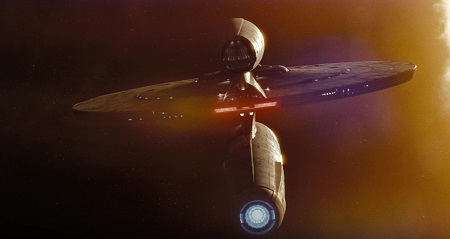
There are many parallel universes, as Tarka reminded us in But To Connect. Though Star Trek has shown us a number of different parallel universes before, the biggest one that comes to mind (aside from the Mirror Universe) is the Kelvin timeline, in which the three reboot films were set.
Now that we know a fourth Kelvin film is happening, a major link-up between the two settings could definitely be on the cards. We don’t know how far the Kelvin timeline and the prime timeline will have diverged by the 32nd Century, and whether it operates like the Mirror Universe with every character getting their own alternate counterpart. If it does, perhaps Tarka met his own Kelvin timeline counterpart and that’s how he cooked up this scheme. If the Kelvin timeline diverged significantly from the prime timeline it stands to reason that the Burn never happened there. We also got an oblique Kelvin timeline reference in Season 3 – could that have been a hint?
Theory #20:
Book will find Kyheem and Leto on the other side of the DMA.
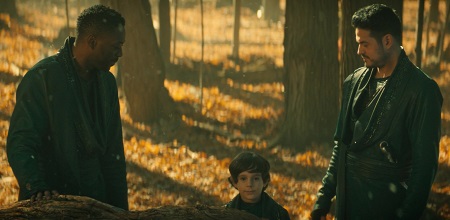
In Star Trek: Generations, Captain Picard encountered Captain Kirk inside the Nexus – despite Kirk being declared “dead” after the Enterprise-B encountered the energy ribbon almost eighty years earlier. Now that we know a little more about how the DMA operates, it seems at least faintly possible that, just like Captain Kirk, the inhabitants of Kwejian may not be as dead as they first appear.
This theory is, I freely admit, a bit of a long-shot. But the wormhole technology that we know the DMA uses seems to be capable of sending some of what it harvests or mines back to Unknown Species 10-C’s base of operations. Maybe that means that some of the people from Kwejian were transported there instead of being killed.
Theory #21:
The Guardian of Forever will be back.
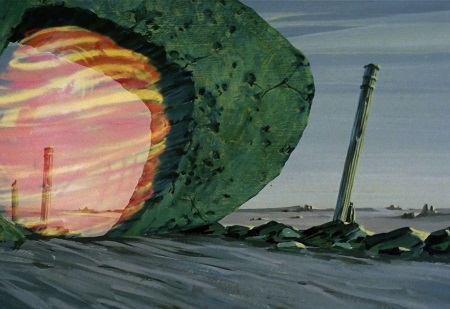
I’m close to retiring this theory. In short, I had suggested that the reintroduction of the Guardian of Forever in Season 3 could mean that we’ll encounter the timeless entity again in Season 4. It would be nice to bring back Paul Guilfoyle, who played the Guardian’s humanoid avatar in the Season 3 two-parter Terra Firma.
However, it seems as though the DMA/Unknown Species 10-C story isn’t going in that direction. It would make sense, in a way, for Captain Burnham to seek out the Guardian to ask it about the DMA and Unknown Species 10-C – it may well know something about what’s going on that could be helpful. But the best time to have done that would have been earlier in the season. There are still ways in which the Guardian of Forever could be included, though – such as Tarka attempting to use it to reach his friend – so although I’m close, I’m not dropping it just yet.
Theory #22:
President Rillak knows what the DMA is and may be implicated in its creation.
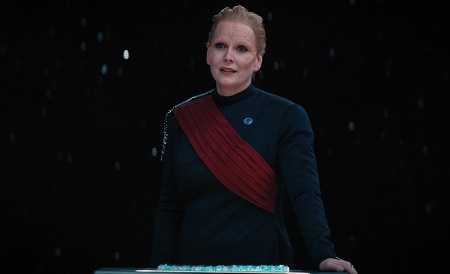
I will admit that, as things stand, President Rillak is looking less and less likely to be involved directly with Unknown Species 10-C and the DMA. But there’s still time for a connection to be revealed!
In short, President Rillak’s single-minded goal of reuniting the Federation may be well-served by providing the disparate ex-members with an enemy or a problem to stand against. The DMA has already accelerated Ni’Var’s membership, and President Rillak even got to speak with a representative from Earth in But To Connect – so if she is involved somehow, her scheme is already paying dividends. At the very least, I think it’s fair to say that this complex, somewhat Machiavellian character is not letting the crisis go to waste, and is politicking off the DMA’s trail of destruction.

In her dealings with Captain Burnham, I’d argue we’ve seen this Machiavellian edge to President Rillak. In the Ni’Var negotiations depicted in All Is Possible, and again for a second time in But To Connect, President Rillak used Captain Burnham to advocate positions that would’ve been politically or diplomatically difficult for her to do openly – effectively manipulating those events from behind the scenes.
In light of all of this, I would hope that Captain Burnham will tread carefully with President Rillak. She seems the type who would happily throw Burnham and the USS Discovery under the bus if it suited her political and/or diplomatic ends. If someone like that felt that unleashing the DMA, or failing to warn everyone that it was coming, would be to her advantage, I can absolutely see her seizing on that opportunity, too. There are myriad ways in which we could connect her to the DMA, even if she didn’t order its creation. She could be in cahoots with Unknown Species 10-C, she could have learned about the DMA and chosen to cover it up, or something else that she believed was in the Federation’s long-term interests.
Theory #23:
Unknown Species 10-C is extinct.
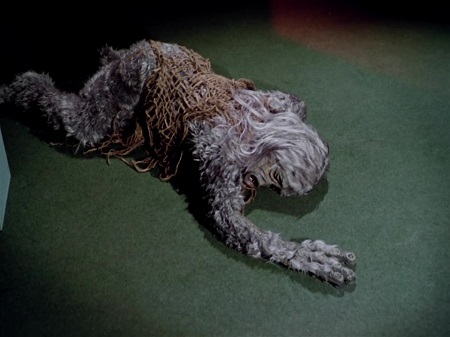
Although the arrival of a second DMA may count against this theory, it’s possible that it’s some kind of automated system. With Unknown Species 10-C still being hidden and mysterious, it seems at least possible that Captain Burnham and the crew will arrive at their base to find it empty; Unknown Species 10-C may have already gone extinct.
Perhaps they went extinct recently, or perhaps it was millennia ago. The DMA might be Discovery’s equivalent of the Planet Killer from The Doomsday Machine; an automated device left behind, a warning to the real world about the dangers of some of our long-lasting environmental and technological impacts.
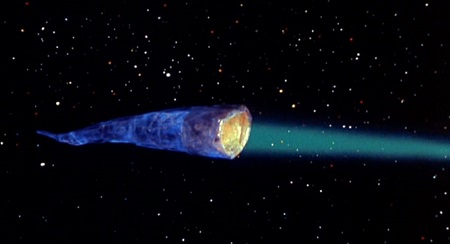
The DMA could even be Unknown Species 10-C’s last-ditch effort to prevent their own extinction. Having used up their entire power supply, they had to build such an imprecise, devastating machine to harvest all of the boronite they could possibly find just to keep the lights on and their machines powered. There could be an interesting analogy there, too.
Because Unknown Species 10-C remains hidden from us going into the next episode, all sorts of possibilities remain on the table. This could certainly be a different and unexpected way to take the story, and perhaps the culmination of the plot would be more of a technological puzzle than a conflict against an adversary, with Captain Burnham leading Starfleet’s efforts to figure out Unknown Species 10-C’s technology in order to deactivate the DMA.
So that’s the main theory list!
We also have two production-side theories in play, so we’ll look at those too before we wrap things up.
Production-side theory #1:
Tilly’s departure will be permanent.

Mary Wiseman confirmed in an interview with Wil Wheaton on The Ready Room (Discovery’s social media aftershow) that Tilly will be seen again before the end of Season 4, and we glimpsed her in the trailer for the second half of the season as well. But that doesn’t mean she will return as a main character on the show going forward, and her departure in All Is Possible felt permanent. Despite that, I’ve seen quite a lot of folks online who don’t believe that Tilly is actually leaving the series – so I wanted to put it out there officially and say that, in my opinion anyway, she is.
Maybe those people know something that I don’t! As I always say, I don’t have any “insider information;” all of this is just speculation on my part. However, I feel that the manner of Tilly’s departure, the fact that she got that emotional sequence with Captain Burnham, a montage showing her leaving the ship, Adira seeming to take over several of her roles, and her departure feeling like the culmination of her arc going back to the latter part of Season 3 all come together to strongly indicate that she won’t be back as a major character. She may yet have a significant role to play in a future Season 4 episode, as has been suggested, but unless Discovery’s writers are really playing with our emotions I believe we’ve seen Tilly’s end as a main character on the show. She may come back in a future Starfleet Academy series, though… so watch this space!
Production-side theory #2:
Season 4 will end on a cliffhanger!

Star Trek has a long, well-established tradition of season-ending cliffhangers! There have been some truly shocking ones in the past, including The Best of Both Worlds in The Next Generation, Deep Space Nine’s Call To Arms, Equinox in Voyager… and many more! With the story of Unknown Species 10-C and the DMA slowly being unpicked, it could be the case that we’ll get a clean resolution – like we did at the end of Season 3. But it’s also possible, in my opinion, that Season 4 will end in similar fashion to Season 2 – on a major cliffhanger!
That could be because the Unknown Species 10-C story didn’t conclude, or a war with the mysterious faction is about to break out. But the Season 4 finale could also set up the beginnings of Season 5’s story, just like how the final moments of Season 1 saw Captain Pike’s Enterprise link up with the USS Discovery.
So that’s it!
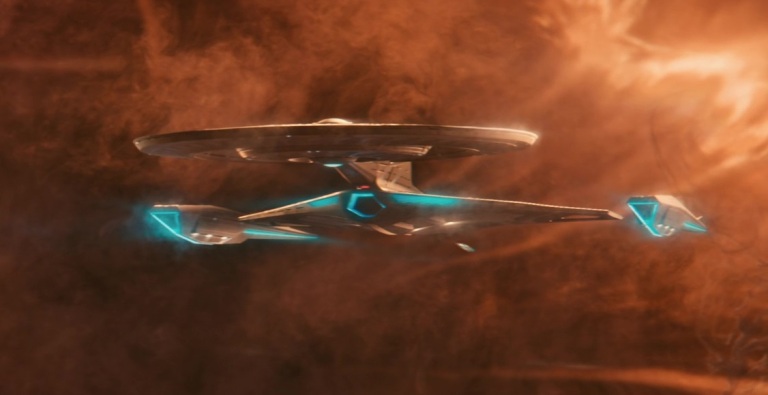
There are still some huge questions facing Discovery as we move into the final four episodes of the season. The DMA and Unknown Species 10-C storylines have to be exposed – somehow – and there’s also the question of Tarka. Will he make it across the divide to the universe he’s trying to reach? And what of Book and Burnham – will they be able to put the arguments over the DMA behind them and reconcile? The next episode will take us to The Galactic Barrier – so maybe we’ll finally get to lay eyes on Unknown Species 10-C!
Before we go, one final point. I write up these theories because I like Star Trek and I like writing. But for some folks, fan theories can hamper their enjoyment of a film or television show. It’s worth keeping in mind that most of these theories probably won’t pan out, and we have to be prepared for the fact that even the most well-constructed fan theory, no matter how fun and plausible it seems, simply won’t turn out to be true. If you find that speculating and reading theories is beginning to detract from your enjoyment of Star Trek: Discovery – or any other television show or film – it might be a good idea to take a break for a while.
Star Trek: Discovery Season 4 is available to stream now on Paramount+ in the United States, Scandinavia, Latin America, and Australia. The show is on Pluto TV in the UK, France, Germany, Italy, and other parts of Western Europe at 9pm on Fridays and Saturdays. Individual episodes or the full season can be purchased on iTunes, Amazon Video, Google Play, and possibly other platforms in the UK, parts of Europe, and select other countries. The Star Trek franchise – including Discovery and all other properties mentioned above – is the copyright of Paramount Global. This article contains the thoughts and opinions of one person only and is not intended to cause any offence.




